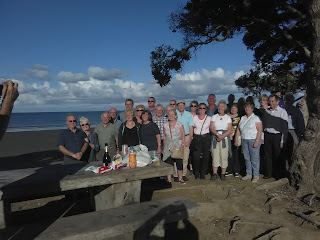California - Day 11 - Cambria via (Monterey, Pebble Beach, Big Sur)
Friday 24th September
Cambria, California
The City of Monterey in Monterey County is located on Monterey Bay along the Pacific coast in Central California. Monterey lies at an elevation of 26 feet (8 m) above sea level. The city is noted for its rich history of resident artists beginning in the late 1800s, and its historically famed fishery. First established in 1770 by Father Junípero Serra and Gaspar de Portolà (governor of Baja and Alta California (1767–1770), explorer and founder of San Diego and Monterey), Monterey served as the capital of California from 1777 to 1849, under the flags of Spain and Mexico.
Pacific Grove is a coastal town, and is known for its Victorian homes, Asilomar State Beach, its artistic legacy and the annual migration of the Monarch butterflies. The city is endowed with more Victorian houses per capita than anywhere else in America; some of them have been turned into bed and breakfast inns.
17-Mile Drive is widely recognized as one of the most scenic drives in the world. The famous coastal landmark runs through Pacific Grove to Pebble Beach, from the dramatic Pacific coastline to the majestic Del Monte Forest. The awe-inspiring vistas and legendary sites can easily fill an entire day with exploration and discovery, although visitors with less time should not miss the opportunity to experience this wondrous journey as well. Marvel at some of nature’s treasures found along 17-Mile Drive including The Lone Cypress – one of California’s best-known landmarks – Spanish Bay, Cypress Point Lookout and Carmel Bay. You can also see the emerald fairways of The Links at Spanish Bay, Spyglass Hill and the world-renowned Pebble Beach Golf Links.
Carmel-by-the-Sea, usually called simply Carmel, is a small town in Monterey County, founded in 1902 and incorporated in 1916. Situated on the Monterey Peninsula, the town is known for its natural scenery and rich artistic history. In 1906, the San Francisco Call devoted a full page to the "artists, poets and writers of Carmel-by-the-Sea," and in 1910 it reported that 60 percent of Carmel's houses were built by citizens who were "devoting their lives to work connected to the aesthetic arts." Early City Councils were dominated by artists, and the town has had several mayors who were poets or actors, including Herbert Heron, founder of the Forest Theater, bohemian writer and actor Perry Newberry, and actor-director Clint Eastwood, who was mayor for one term, from 1986 to 1988.
The Carmel Mission - San Carlos Borromeo de Carmelo was founded on June 3 of 1770 in the nearby settlement of Monterey, but was relocated to Carmel by Father Junipero Serra due to the interaction between soldiers stationed at the nearby Presidio and the native Indians.
In December of 1771, the transfer was complete as the new stockade of approximately 130x200 ft, became the new Mission Carmel. Simple buildings of plastered mud were the first church and dwellings until a more sturdy structure was built of wood from nearby pine and cypress trees to last through the seasonal rains. This too was only a temporary church until a permanent stone edifice was built. In 1784, Father Serra, after one last tour of all the California missions, died and was buried at his request at the Mission in the Sanctuary of the San Carlos Church, next to father Crespi who had passed the previous year. He was buried with full military honours.
Big Sur is a sparsely populated region of the central California coast where the Santa Lucia Mountains rise abruptly from the Pacific Ocean. The name "Big Sur" is derived from the original Spanish-language "el sur grande", meaning "the big south", or from "el país grande del sur", "the big country of the south". The terrain offers stunning views, making Big Sur a popular tourist destination. Big Sur's Cone Peak the highest coastal mountain in the contiguous 48 states, ascending nearly a mile (5,155 feet/1571 m) above sea level, only three miles (4.8 km) from the ocean.
Cambria the earliest human settlement of this area is associated with prehistoric habitation by the Native American Chumash peoples, who exploited marine resources along the coastal area, with emphasis upon sites that were streamside in nature. Cambria is located on the Rancho Santa Rosa Mexican land grant given in 1841 Julian Estrada.
The Journey
Leaving San Francisco, hopefully with our “hearts”, we have to ask is “Anyone going to San Jose”, as that is the direction we are heading, passing round the city we travel in to the large agricultural area, known as the “Salad Bowl”, our first stop shall be in Monterey (10.40), time to try some Cinnamon Buns !!! on leaving we travel along Pacific Grove, and 17 Mile Drive, before arriving in Carmel for our lunch stop (13.30). After lunch we continue along Highway 1 or better known as Big Sur, our afternoon stop will be at the Julie Pheiffer Park, (15.00) where we find some redwoods, and an ice cream. Late afternoon we arrive in Cambria and head to our hotel The Cambria Pines (18.00), a lovely situation, again in Motel style buildings, surrounded by lovely gardens, a restaurant and a bar are available with musical entertainment. The restaurant is busy this evening, reservations a re required, later I shall pass round a sheet for this purpose, please join up with others if you can to make larger tables, light snacks are also available in the bar.


Comments
Post a Comment